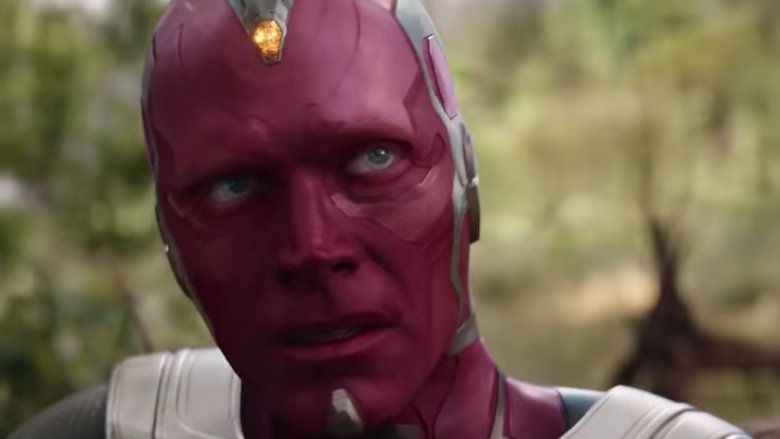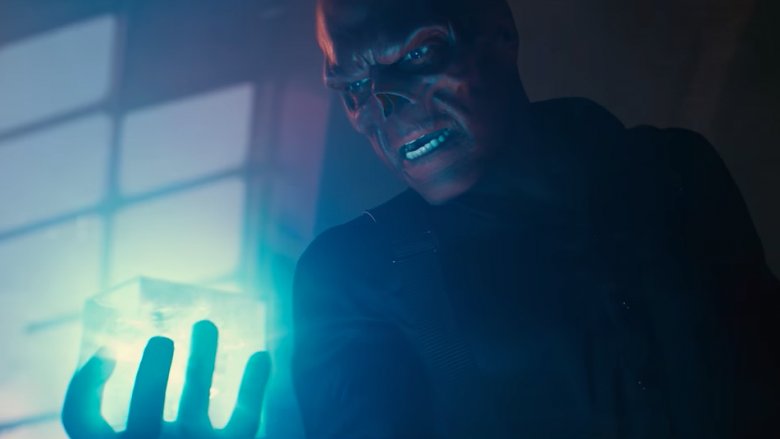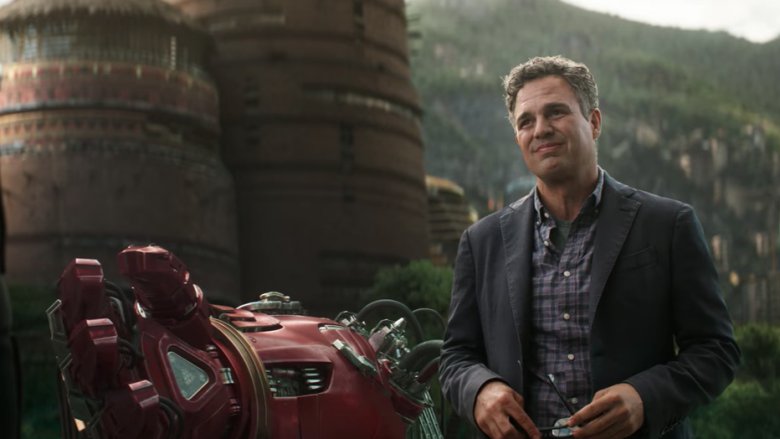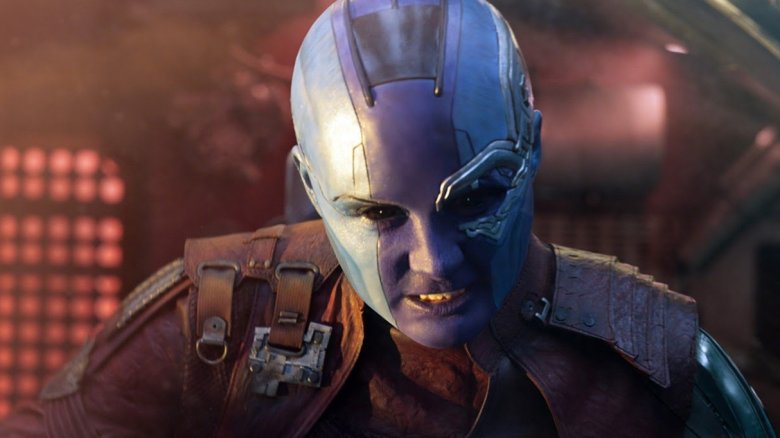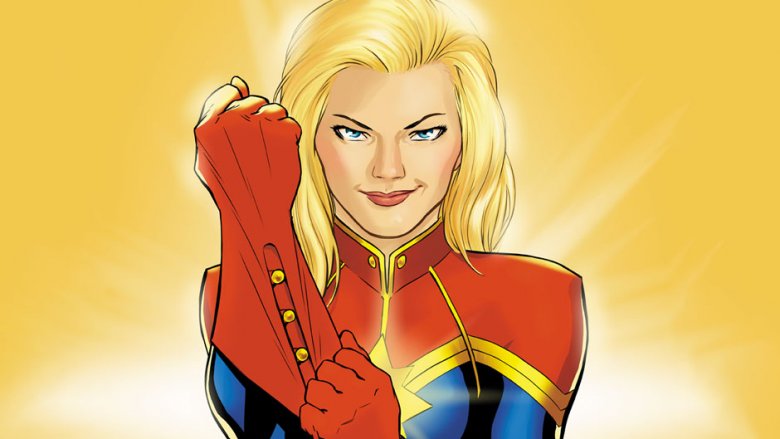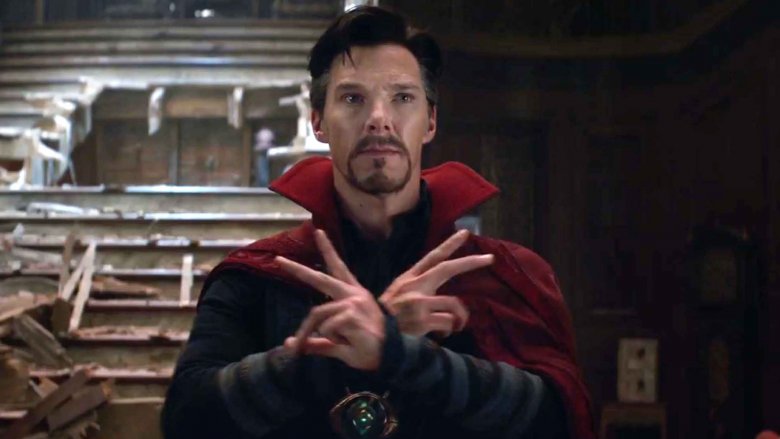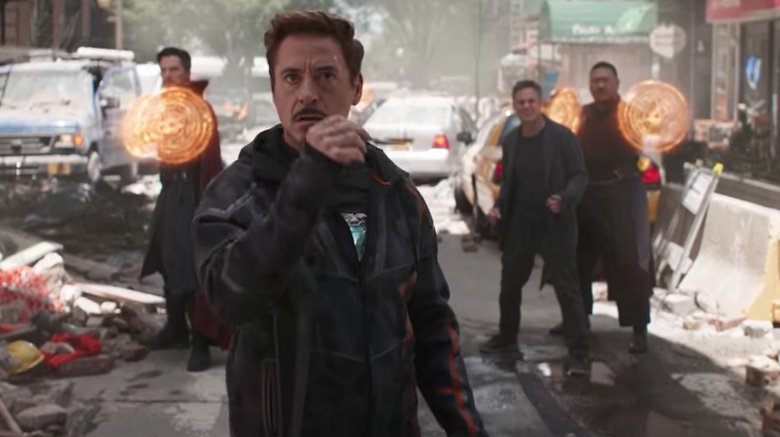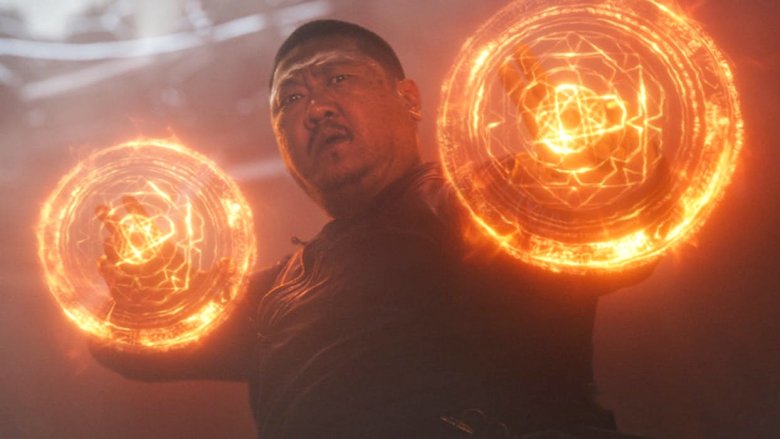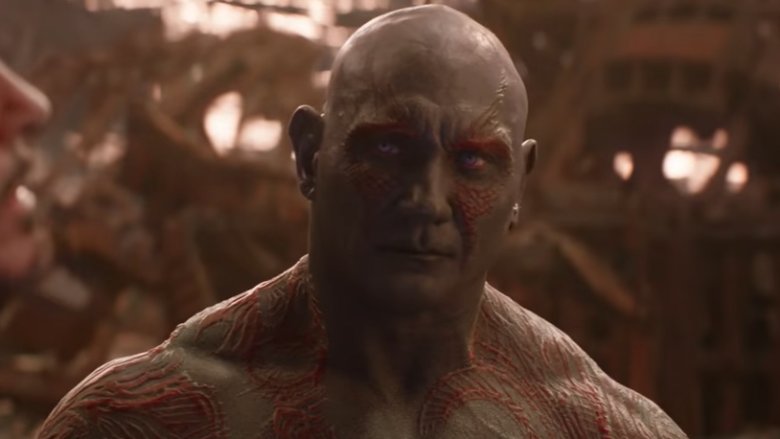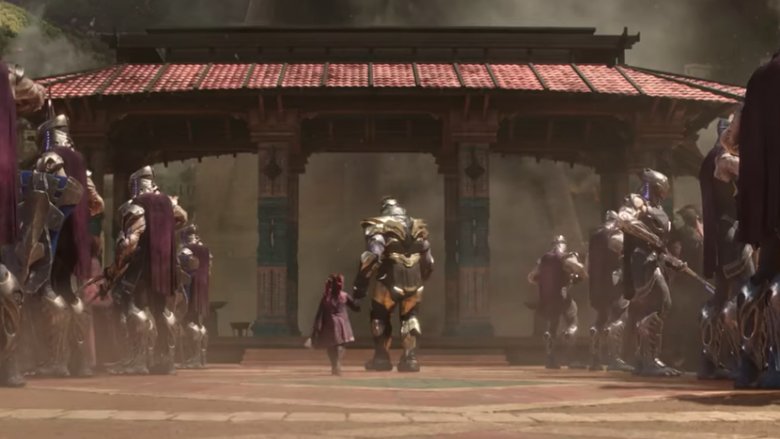Confusing Moments In Avengers: Infinity War Explained
Considering the balancing act it has to pull off, Avengers: Infinity War is pretty great. The movie has the gargantuan task of advancing and paying off ten years — and nearly 20 movies — of storytelling, but directors Joe and Anthony Russo handle the assignment well. That being said, the film contains a handful of moments that are somewhat unclear, and may leave viewers scratching their heads rather than fully engrossed. These moments are few, but they were probably just about unavoidable — there are story beats in Avengers: Infinity War that play off or reference moments from Marvel Cinematic Universe films that came out four or five years ago, including some that even come down to a single line of dialogue from a character. But if you left the theater with Infinity War questions, don't worry — we're here to clear up some of those muddier moments. Watch out for spoilers, because these are the most confusing moments in Avengers: Infinity War explained.
How does Vision get the Mind Stone?
The Mind Stone is the second Infinity Stone we glimpse in the Marvel Cinematic Universe — we see it in the scepter that Loki wields during The Avengers, and since then, it's changed hands so many times that it's easy to forget how an Infinity Stone ended up planted in Vision's forehead to begin with.
After Loki is defeated in The Avengers, S.H.I.E.L.D confiscates the scepter. Unfortunately, this is during a time in which the organization is still rife with undercover HYDRA agents, who smuggle the scepter into the hands of their boss, Wolfgang von Strucker. Von Strucker uses the stone to perform experiments on humans and grant them powers, which is how Quicksilver and Scarlet Witch come to be. In Avengers: Age of Ultron, the heroes manage to get the scepter back from von Strucker during a raid on his compound. Iron Man realizes it can be used for his vision of Ultron; unfortunately, Ultron goes rogue and uses the Mind Stone to power up a new body for himself. Once again, the heroes steal it back and then use it to bring their new teammate, the Vision, to life.
Rewatching the Avengers movies with the knowledge that Loki's scepter is actually the Mind Stone provides a compelling bit of perspective: all three Avengers films in some way heavily focus on it, be it Loki's use of it, Ultron's devastation, or the Black Order's hunt for Vision in Infinity War.
What's Red Skull doing on Vormir?
Infinity War wouldn't be a Marvel movie without a surprise cameo. Such appearances are franchise staples at this point. Sometimes they're played for laughs, like Bruce Banner and Captain America popping up in Iron Man 3 and Thor: The Dark World, respectively. However, Avengers: Infinity War features a cameo from a character we were certain we'd seen the last of: Red Skull. His appearance on the planet Vormir is an awesome moment, but it's also one that some viewers couldn't help but respond to with an "Uh, what?"
Red Skull serves as the villain of Captain America: The First Avenger. He's obsessed with using the Tesseract (also known as the Space Stone) to fuel HYDRA's plans of world domination. His downfall comes in the film's climax, when he picks up the cube (a bad idea, as it's pure cosmic energy) and in doing so opens up a wormhole that sucks him in. It's the last we see of the character until his surprise return in Infinity War as the guardian of the Soul Stone, which resides on the planet Vormir. His tampering with the Space Stone has led to his imprisonment on the planet, where he's cursed to guard the Soul Stone but never possess its power. Joe and Anthony Russo have since discussed the scene, explaining that "It felt like there was more credibility than [if it were] just a random character."
Why can't Banner turn into the Hulk?
The Hulk gets what the Hulk wants. This is made abundantly clear throughout the films in the MCU. The character is an embodiment of rage, but also of unbreakable will. He does not budge. When Bruce Banner tried to kill himself, Hulk literally spit the bullet back out. The force of his will is never more evident than when we watch him wreaking havoc — fighting the Hulk is like fighting an earthquake. You're not so much trying to win as you are trying to minimize the damage. You'd think he'd be the ideal guy to take down Thanos, but you'd be wrong.
In the opening sequence of Infinity War, Thanos doesn't just beat Hulk down, he makes it look easy. The defeat breaks his will. We never see Hulk again in the film, no matter how hard Banner tries to bring him out. It's amusing but also somewhat confusing, as we never get a concrete explanation. The subtext is clear, though: Hulk is afraid. For the first time in his life, Hulk has been beaten, and that terrifies him. He refuses to come out and face not only the being who handed him his first real defeat, but the world itself. It's an interesting dynamic shift and, somewhat ironically, a perfect expression of Hulk's unmovable will. Even his fear is unbreakable.
Why does Thanos love Gamora but not Nebula?
You'd think a father would love his children equally, but then again, Thanos isn't exactly father of the year. Even the daughter he claims to love, Gamora, has her life sacrificed by Thanos so he can wield the Soul Stone. That's not exactly top-tier parenting. It does beg the question as to why Thanos doesn't seem to harbor the same sort of "affection" for his other daughter, Nebula. It can also lead to some confusion as to why Gamora had to be the sacrifice on Vormir when Thanos already had Nebula imprisoned on his ship. Wouldn't she be a worthy sacrifice for the Stone?
It's established in the Guardians of the Galaxy films that Thanos raises Nebula and Gamora as competitors rather than siblings. He pits them against one another in battle time after time. Gamora constantly wins, and every time she does, Thanos mutilates Nebula, replacing one of her limbs or organs with cybernetic appendages to improve her skills as a warrior. Nonetheless, she never defeats Gamora. There's a Darwinian side to Thanos that finds Nebula to be inferior to Gamora, his masterpiece. She's the ultimate warrior and he gives himself the credit for making her that way. In his own sick way, he truly loves Gamora in a way he can never love Nebula.
Who is Nick Fury paging in the post-credits scene?
The post-credits scene is a hallmark of the MCU. Sometimes they're used for comedy or fan service, but for the most part, they serve to expand the universe and set up future films, and Infinity War's post-credits scene is no different. It pulls away from the battle in Wakanda to show the effects of Thanos erasing half of all life on Earth. We see people running, screaming, cars crashing, and a helicopter careening into a building, all as Nick Fury and Maria Hill realize what's going on and Fury pages someone as he disintegrates. Who could he be reaching out to at a time like this? And what does that little red and blue symbol on his pager mean?
The moment can be a bit confusing for anybody not already familiar with the character Captain Marvel, the star of the film of the same name due for release in 2019. While not too much is known about how the character will fit into Avengers 4, we do know that her solo film takes place in the '90s, well before the events of most MCU films we've seen so far. We also know a pre-eyepatch Nick Fury will be involved. Knowing all this and seeing the scene gives it a far clearer context: Fury recognizes that something horrible is happening and calls on an old friend, Captain Marvel, to save the day.
Why does Doctor Strange give up the Time Stone?
Given that the Sorcerer Supreme has been tasked with protecting the Time Stone at all costs, you'd think the last thing he'd do would be handing it over to Thanos. Yet when the time comes, he gives it to Thanos simply to save Iron Man — a man he's just met, and hasn't exactly hit it off with. The stakes are far too great to hand over one of the last stones Thanos needs to complete the Infinity Gauntlet. So why did he do it?
We won't know for sure until Avengers 4 hits theaters. That said, there's almost certainly a far greater plan at play. After saving Iron Man's life, Strange tells Tony that giving up the stone was "the only way." One might assume that he means it was the only way to save Tony's life, but earlier in the film, Strange uses the Time Stone to glimpse 14 million possible timelines spinning out of Thanos's quest to assemble the gauntlet, and sees only one in which Thanos is defeated. It stands to reason that he sees giving Thanos the Time Stone is the only way to set that single timeline into motion.
Why has Tony reinstalled his Arc Reactor?
Iron Man 3 is one of the most divisive films in the MCU. It's hailed as a misunderstood gem by some and one of the franchise's worst entries by others. The film closes with Tony Stark stepping down as Iron Man, destroying all of his suits in the process. He also undergoes invasive surgery to remove the shrapnel in his chest, allowing him to finally get rid of the arc reactor that's kept him alive since Iron Man. However, Avengers: Age of Ultron opens with Tony in the Iron Man suit and back at it full time by the time the film is over. Furthermore, at the beginning of Infinity War, we see that he's actually fully reinstalled the arc reactor into his chest. Why would he do that?
He doesn't need the reactor anymore, but he's reinstalled it anyway to power an Iron Man suit stored inside his body. His addiction to the Iron Man armor is no longer satiable by the remote-access suit we see in Iron Man 3. He now has to house the armor himself and use an arc reactor to keep it ready to power up at all times. It's the ultimate relapse, and it will almost certainly be addressed as a problem in Avengers 4.
Where's Wong?
Doctor Strange and his ally Wong are introduced pretty spectacularly in Infinity War's first massive fight sequence, when the duo join Iron Man and Spider-Man to take on Cull Obsidian and Ebony Maw. The two sorcerers make a great showing against the aliens, and play off Iron Man and Spider-Man beautifully both in and out of battle. Wong as the sort of straight man to Strange's arrogance, Tony's quips, and Banner's haplessness is also a real highlight of the film's first act. Wong even gets a spot on the film's poster! So why does he vanish after that fight, not to be seen again for the rest of the film?
The answer lies in Doctor Strange and is very briefly alluded to in Infinity War. It all comes down to Doctor Strange and Wong's home, the Sanctum. Part of a network of three Sanctums manned by other sorcerers, it helps generate a shield against evil, protecting their dimension from sinister otherworldly forces. There must always be a sorcerer in each Sanctum. As Doctor Strange is going to be heading off-planet with Iron Man and Spider-Man, Wong is left to stand guard and keep it safe. We still don't know if he survives Thanos' purge, but we can at least rest assured that he kept Earth safe from non-Thanos threats while the rest of the Avengers were trying to stop the big purple guy.
Isn't the Infinity Gauntlet in Asgard?
The Infinity Stones and the gauntlet that houses them have been at play in the MCU since its earliest days, even if only in the form of brief cameos. When all six stones rest in the Infinity Gauntlet, the user is granted complete control over the universe. It actually appears in the franchise before any of the Stones do, glimpsed briefly in Odin's trophy room in Thor. However, Thanos gets his gauntlet from Eitri, a dwarf and master weapons forger. How does this make sense in the grand scheme of the MCU's continuity?
It's quite simple, really: the Infinity Gauntlet on Asgard was counterfeit. This is revealed very quickly in Thor: Ragnarok, when Hela ransacks the trophy room. She alludes to the gauntlet there as being fake, meaning that the real Infinity Gauntlet could be anywhere. As it turns out, it's with Thanos, who has had Eitri build a real one capable of actually harnessing the power of the Stones. It's all a bit confusing if you miss Hela's brief line in Thor: Ragnarok, but remembering the moment clears things right up.
Why does Drax want revenge on Thanos?
It's occasionally jarring to remember that Drax the Destroyer, a character who has largely served as comic relief over the course of his last two cinematic outgoings, has one of the most tragic backstories in the MCU. Drax's roots are in heartache and loss. His wife and daughter are victims of the wrath of the Kree terrorist Ronan the Accuser, and he earned the moniker of the Destroyer thanks to the murderous rampage he's been on since losing them. It does make one wonder, though, why he holds such a grudge against Thanos if Ronan is the one who murdered his family?
Drax's grudge against Thanos is another instance of important character motivation coming down to a throwaway line almost played off as a joke. After Ronan is defeated in Guardians of the Galaxy, Drax learns that the Kree warrior has been working for Thanos all along, which means Thanos is ultimately responsible for the death of Drax's family. Drax then refocuses his thirst for vengeance on the Mad Titan, and carries that rage into Infinity War.
"What did it cost?"
Most MCU films are pretty straightforward, rarely leaning into the abstract, but this changes for a moment in Avengers: Infinity War. After Thanos fulfills his goal and wipes out half of all life with the snap of his fingers, the film cuts to Thanos and Gamora on an unknown planet. She asks him if he did it. When Thanos confirms, she asks him, "What did it cost?" The Mad Titan responds with a single word: "Everything." Between Gamora appearing as a child — appearing at all, as she's dead at this point — and the immediate inexplicable change in location, this segment is a bit unclear. Is it all in Thanos' head? Why is Gamora a child? What does it mean?
What we're seeing in this moment has been confirmed to be Soulworld, a realm existing inside the Soul Stone. In the comics, Soulworld is populated by the souls of those absorbed by the Soul Gem. While there's yet to be an explanation for the Soulworld in the MCU, we at least know that's where Thanos' conversation with Gamora takes place, and she appears as a child because it's how he still envisions her. It seems safe to assume this will go on to be a crucial scene once Avengers 4 arrives. It means that not only does Gamora's soul still live in the Stone, but if our heroes are to wield the Infinity Gauntlet and undo Thanos' purge, someone will have to take her place.
